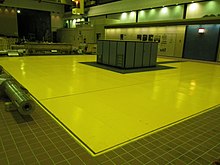
Back Wasserkraftwerk Churchill Falls German Centrale de Churchill Falls French Hidroelektrana Churchill Falls Croatian ჩერჩილის ჩანჩქერის ჰიდროელექტროსადგური Georgian Waterkrachtcentrale Churchill Falls Dutch Черчилл-Фолс (ГЭС) Russian Hidroelektrana Churchill Falls Serbo-Croatian Churchill Falls vattenkraftverk Swedish ГЕС Черчилл-Фоллз Ukrainian Thủy điện Churchill Falls Vietnamese
| Churchill Falls Generating Station | |
|---|---|
 | |
| Location | Newfoundland and Labrador, Canada |
| Coordinates | 53°31′43.45″N 63°57′57.15″W / 53.5287361°N 63.9658750°W |
| Construction began | 1967 |
| Opening date | 1974 |
| Construction cost | 946 million CAD |
| Owner(s) | CF(L)Co |
| Dam and spillways | |
| Type of dam | 88 rock-filled dikes |
| Impounds | Churchill River |
| Length | 64 km (40 mi) |
| Dam volume | 2,200,000 m3 (2,900,000 cu yd) |
| Reservoir | |
| Creates | Smallwood Reservoir Ossokmanuan Reservoir |
| Total capacity | 32.64 km3 (1.153×1012 cu ft) |
| Catchment area | 71,750 km2 (27,700 sq mi) |
| Surface area | 6,988 km2 (2,698 sq mi) |
| Power Station | |
| Operator(s) | CF(L)Co |
| Commission date | 1971-74 |
| Hydraulic head | 312.4 m (1,025 ft) |
| Turbines | 11 |
| Installed capacity | 5,428 MW |
| Capacity factor | 73.6% |
| Annual generation | 35,000 GWh (130,000 TJ) |
| Website nalcorenergy | |
The Churchill Falls Generating Station is a hydroelectric underground power station in Labrador. At 5,428 MW, it is the sixteenth largest in the world, and the second-largest in Canada, after the Robert-Bourassa generating station in northwestern Quebec.
Rather than a single large dam, the plant's reservoir is contained by 88 dykes, totalling 64 km in length. The Smallwood Reservoir has a capacity of 33 cubic kilometres in a catchment area of about 72,000 square kilometres, an area larger than the Republic of Ireland. It drops over 305 metres to the site of the plant's 11 turbines.
The plant's power house was hewn from solid granite 300 metres underground. It is about 300 metres long and as high as a 15-story building.[1]
The station cost almost a billion Canadian dollars to build in 1970. Commissioned from 1971 to 1974, it is owned and operated by the Churchill Falls Labrador Corporation Limited, a joint venture between Nalcor Energy (65.8%) and Hydro-Québec (34.2%). Workers at the station live in the purpose-built company town of Churchill Falls.
The ongoing Lower Churchill Project is a joint venture between Nalcor and Emera[2] to develop the remaining 35 percent of the Churchill River basin.[3][4][5]
- ^ "Top 10 hydroelectric dams in Canada". Canadian Mining & Energy. 27 October 2015. Retrieved 2019-07-21.
- ^ McCarthy, Shawn (18 November 2010). "Churchill hydro deal signals era of Atlantic co-operation – The Globe and Mail". The Globe and Mail. Toronto.
- ^ "Government of Newfoundland and Labrador Announces Sanction of the Muskrat Falls Development". Government of Newfoundland and Labrador. December 17, 2012. Retrieved Nov 29, 2020.
- ^ "$1.5B Maritime Link approved by Emera Inc". CBC News. Dec 18, 2012. Retrieved Nov 29, 2020.
- ^ "Maritime Link energy project approved by Nova Scotia's UARB". CBC News. Nov 29, 2013. Retrieved Nov 29, 2020.
